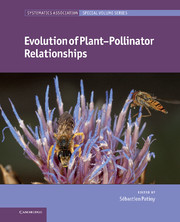Book contents
- Frontmatter
- Contents
- Contributors
- Preface
- 1 Macroevolution for plant reproductive biologists
- 2 Pollination crisis, plant sex systems, and predicting evolutionary trends in attractiveness
- 3 Evolution and ecological implications of “specialized” pollinator rewards
- 4 Fig–fig wasp mutualism: the fall of the strict cospeciation paradigm?
- 5 Fossil bees and their plant associates
- 6 Pollen evidence for the pollination biology of early flowering plants
- 7 Pollinator mediated floral divergence in the absence of pollinator shifts
- 8 Animal pollination and speciation in plants: general mechanisms and examples from the orchids
- 9 Why are floral signals complex? An outline of functional hypotheses
- 10 A survey on pollination modes in cacti and a potential key innovation
- 11 Zygomorphy, area, and the latitudinal biodiversity gradient in angiosperms
- 12 Ambophily and “super generalism” in Ceratonia siliqua (Fabaceae) pollination
- 13 Structure and dynamics of pollination networks: the past, present, and future
- 14 Pollinators as drivers of plant distribution and assemblage into communities
- 15 Effects of alien species on plant–pollinator interactions: how can native plants adapt to changing pollination regimes?
- 16 Pollen resources of non-Apis bees in southern Africa
- 17 Advances in the study of the evolution of plant–pollinator relationships
- Index
- Plate section
- References
3 - Evolution and ecological implications of “specialized” pollinator rewards
Published online by Cambridge University Press: 05 January 2012
- Frontmatter
- Contents
- Contributors
- Preface
- 1 Macroevolution for plant reproductive biologists
- 2 Pollination crisis, plant sex systems, and predicting evolutionary trends in attractiveness
- 3 Evolution and ecological implications of “specialized” pollinator rewards
- 4 Fig–fig wasp mutualism: the fall of the strict cospeciation paradigm?
- 5 Fossil bees and their plant associates
- 6 Pollen evidence for the pollination biology of early flowering plants
- 7 Pollinator mediated floral divergence in the absence of pollinator shifts
- 8 Animal pollination and speciation in plants: general mechanisms and examples from the orchids
- 9 Why are floral signals complex? An outline of functional hypotheses
- 10 A survey on pollination modes in cacti and a potential key innovation
- 11 Zygomorphy, area, and the latitudinal biodiversity gradient in angiosperms
- 12 Ambophily and “super generalism” in Ceratonia siliqua (Fabaceae) pollination
- 13 Structure and dynamics of pollination networks: the past, present, and future
- 14 Pollinators as drivers of plant distribution and assemblage into communities
- 15 Effects of alien species on plant–pollinator interactions: how can native plants adapt to changing pollination regimes?
- 16 Pollen resources of non-Apis bees in southern Africa
- 17 Advances in the study of the evolution of plant–pollinator relationships
- Index
- Plate section
- References
Summary
Introduction
The transfer of pollen between flowers by animals or abiotic agents is a critical event in the reproduction of most flowering plant species, affecting both the number and quality of offspring (seeds) produced. Most plants attract animal pollinators to their flowers by offering nectar, pollen, or edible floral parts to these mutualists. A small but significant number of angiosperm species offer other kinds of rewards, which I will call “specialized” rewards. Yet other species offer no rewards at all, instead deceiving their pollinators, eliciting visitation without any compensation whatsoever.
While the list of plants known to offer specialized pollinator rewards has been growing, we still know relatively little about the evolution of these pollinator-attraction systems or their effects on community ecology. In particular, the ecological implications of such reward systems have not been factored into thinking about pollination networks or the relationship between specialization and vulnerability to anthropogenic disturbance. This chapter reviews these issues using published data and unpublished observations to assess the evolutionary dynamics and ecological importance of pollination relationships based on specialized rewards.
- Type
- Chapter
- Information
- Evolution of Plant-Pollinator Relationships , pp. 44 - 67Publisher: Cambridge University PressPrint publication year: 2011
References
- 6
- Cited by

